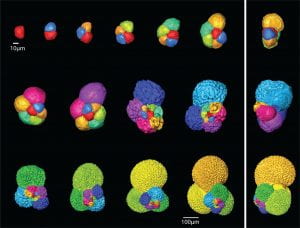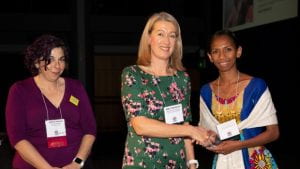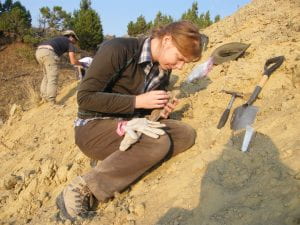Many young people get excited about the idea of working as a palaeontologist. They see the TV documentaries and movies, and think this is a life of excitement and travel, and it is open to everyone.
The excitement and travel are true, but it might be good to think about who pays the wages, and then how to prepare for such a job. Most palaeontologists are employed by universities and museums, and their role in both cases is to contribute to education and to science.
What does a palaeontologist do?

Not all palaeontologists study dinosaurs. In fact, most don’t. Palaeontologists study all aspects of the history of life on Earth, including fossil plants, insects, shellfish, and microscopic plankton. Their work informs us about four things:
- How ancient plants and animals lived and functioned (palaeobiology).
- The evolutionary relationships of all these ancient critters (phylogenetics).
- How ancient ecosystems were constructed and how they functioned (palaeoecology).
- How life responded to ancient climates and Earth conditions (climate change).
So, it’s not all fossil hunting. In fact, many palaeontologists don’t do any fossil hunting at all. So, you don’t have to be a rough, tough outdoors person to be a palaeontologist.
But there can be fieldwork and there can be travel, if you enjoy that. One of the glories of modern palaeontology – like all modern science – is that you work with people from all over the world. This kind of international collaboration is one of the best aspects.
Building your career

If you are reading this at a young age, it might seem to take a long time before you can get that dream job, but it is a fact that palaeontologists, like all scientists and other professionals, get their first jobs usually after the age of 25. This is because you have to study hard through all the stages of school and university before you are qualified to be a researcher and educator.
Remember that palaeontology is a science, and in all the studies you do you need modern scientific skills, especially in computation, but also mathematics, biology, geology, and maybe chemistry and physics. Seven steps.
- So, if you are still at school, you have to plan ahead to go to University and study subjects at high school that get you ready to do a science degree – so work hard on your mathematics, computer studies, biology, chemistry and physics. If your school offers geology, take it…
- Then try to choose a University that already has a palaeontology research group, and join that department (it might be a Department or School of Geology, Earth Sciences, Biology, Zoology, or Botany). You can find out about the professors in different universities by looking up their web pages. If there is a group doing exciting stuff, join that University and that Department, and you will get a chance to work with those people.
- During your first degree, usually a Bachelor’s degree in Geology or Biology, say, you will probably have the chance to do a project in your final year. You might also be able to do a summer research internship. These chances to do research are the very best preparation for a professional career.
- You probably still aren’t there yet. Most jobs in palaeontology require at least a Masters degree. You can take a Masters in Palaeobiology, Systematics, Phylogenetics, or Museum Studies. This is enough for some jobs, especially working as a museum curator or educator. If you want to be an educator, take every chance during your Bachelors and Masters degrees to do outreach work – rocking up to a school to talk about dinosaurs or climate change, taking part in a science fair, etc.
-

Dr Femke Holwerda doing some fieldwork in the Morrison Formation in Wyoming, putting together a sauropod tibia fragment. If you want to become an independent researcher, you also require a PhD, and that can be a tough challenge. There are never enough PhD positions to go round, so competition can be intense. But if you did great research during your undergraduate and Masters degrees, and especially if you published that work in a scientific journal, you are ready to undertake a PhD. This is very different from the earlier degrees you did, because you do this independently; you have one or two professors as mentors, but you have to drive the work yourself. Usually you learn a huge amount about a particular fossil group, but also you learn advanced skills in computing and other topics, such as organic chemistry, geographic information systems, phylogenetics, biomechanics… In fact, the best PhD work has cross-overs into other areas of science, where you spend a lot of time learning from geologists, climate change experts, or biologists.
- You have your PhD, and surely you can now be a professor? Not quite. You still have to get that first job, and that might be a short-term contract, working either as a postdoc or as an educator in a museum or undergraduate college. This is where the skills of independence, critical thought, and persistence that you learned through your earlier career come into play. A key skill is resilience, or the ability to bounce back; if the experiment doesn’t work first time, try again. If the reviewers of your first paper provide nasty comments, take a deep breath and try to work through their critique and improve the paper. Building a portfolio of published work is the key. Additional skills are in education (take every chance to present your work in talks and posters at all levels, from school classes and science fairs to international conferences).
- Finally, you get a real, permanent job. There aren’t so many of these, and often they are not advertised specifically as ‘palaeontology professor; requires person who loves dinosaurs and wants a huge salary’. Mostly, salaries are not huge. Such a job might attract 100 applications, so competition can be intense. Also, palaeontologists often get jobs advertised as ‘evolutionary biologist’ or ‘natural history curator’ or ‘climate change expert’ or ‘zoologist’, so by this stage you should have the skills to convince the hiring committee that your expertise matches their requirements.

